A 16-month-old female presents with lethargy and edema
Click Here to Manage Email Alerts
A 16-month-old female presents to your humanitarian aid clinic in a developing, post-war country for evaluation of decreased activity, lethargic behavior, puffy face and a skin rash with loss of hair. Little is known about her background, including immunizations, but it is known that she is displaced and comes from an economically deprived background, not unlike many others who are trying to survive under similar difficult circumstances, and that she has had bouts of recurrent to chronic diarrhea for a couple of months with progressive loss of appetite. No other family members are sick. Her diet was breast milk until a younger sibling was born, causing the patient to be weaned to table foods about six months prior to this visit.

Vice Chair for Education at The Children’s Hospital at Scott
and White and Associate Professor of Pediatrics at Texas A&M University,
College of Medicine, Temple, Texas. E-mail: jhbrien@aol.com.
e-mail:jhbrien@aol.com
Examination reveals a child with generalized edema with a “moon face,” thinning, reddish hair, apathetic facial affect and eczematous skin with ulcerations and flaky appearance, particularly on the extremities, as shown in figures 1-2. No lab tests are available.
What’s Your Diagnosis?
- Acrodermatitis enteropathica
- Kwashiorkor
- Nephrotic syndrome
- Marasmus
The appearance of this child is classic for B, Kwashiorkor, which is an African word meaning “first-second” or “rejected one”, in reference to the first child who has lost his or her main source of protein in their diet (breast milk) with the close birth of a sibling, as they then rely on table foods that are often protein-deficient, which is the underlying cause of this form of malnutrition. The generalized edema is due to leaky vessels from the severe hypoproteinemia. The skin rash and loss of hair and its pigment, giving it a pale or reddish color is mostly due to a deficiency of micronutrients, such as zinc. Other problems include enlarged, fatty liver and adverse effects on the brain, kidneys, bones, heart, GI tract, pancreas and the immune system.
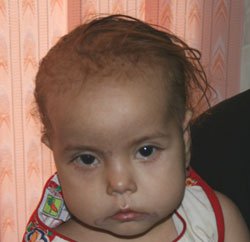 |
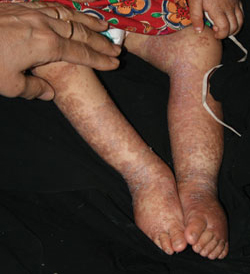 |
|
Figure 1: Child with “moon face,”
thinning hair and apathetic facial affect. |
Figure 2: Eczematous skin with ulcerations and
flaky appearance. |
This is not intended to be a comprehensive review of the very complex pathophysiology of the different forms of malnutrition, especially since I’m not an expert. But, in general, Marasmus is primarily a caloric deficiency, mostly affecting infants, resulting in generalized wasting with the loss of subcutaneous fat, most notably in the gluteal area (figure 3), as opposed to the protein malnutrition of Kwashiorkor, which may be associated with adequate or inadequate caloric intake. Displaced and refugee children frequently have both, significant protein and caloric deficiency, resulting in a mixed deficiency, often referred to as marasmic kwashiorkor. Both are associated with deficiency of multiple micronutrients such as iron, vitamins B, C, D and A as well as zinc.
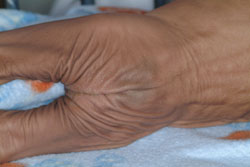 |
|
Figure 3: Generalized wasting with loss of
subcutaneous fat. |
Pure zinc deficiency, either from a hereditary selective malabsorption, excessive losses or a diet deficient in zinc is the usual cause of Acrodermatitis Enteropathica, but the skin and hair changes are very similar to those seen above. However, Acrodermatitis Enteropathica would not likely be associated with the edema seen in kwashiorkor.
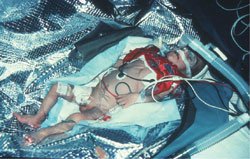 |
|
Figure 4: Patient with septic shock and
pneumonia. |
Nephrotic syndrome (NS) usually presents with edema, but is not associated with nutritional protein deficiency, but rather renal losses of protein. Therefore, some of the other manifestations of the nutritional deficiencies seen with Kwashiorkor, such as the hair and skin changes are not part of the picture with NS.
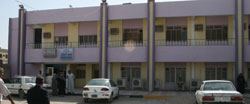 |
|
Figure 5: Nutritional Rehabilitation Center at
Basra General Hospital. |
By now you may be wondering why I would use a non-infectious disease case in this column. Well, the answer is, malnutrition is often referred to as the most common cause of secondary immunodeficiency worldwide, and that close to 5 million children less than 5 years of age die from complications associated with malnutrition per year worldwide. Infections play a dominate role in this grim statistic; usually pneumonia with sepsis, due to the effects that starvation has on the immune system. Every arm of the immune system is adversely affected with starvation, especially the cellular system. The patient shown in figure 4 presented to our Combat Support Hospital in 1991 in Iraq with septic shock and pneumonia. He was successfully resuscitated and evacuated back to a Medical Center in Saudi Arabia, but one can easily see the severe malnutrition (Marasmus) that afflicted this baby. The baby with Kwashiorkor discussed above was photographed 18 years later in the same country at the Basra General Hospital in their special Nutritional Rehabilitation Center (figure 5), where this ragged-looking building housed an entire ward of babies and children with malnutrition (figures 6) receiving surprisingly sophisticated care and specially prepared formulas for each patient’s individual needs. These pictures were taken during a medical education (CME) trip a few of us (Dr., John Podgore, Christopher Cooper, PA and I) made to Southern Iraq in October 2009.
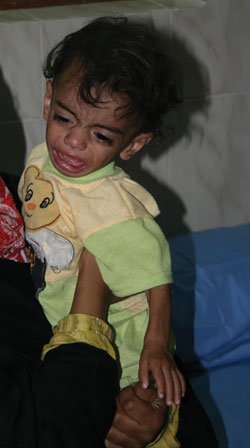 |
|
Figure 6: One of the many malnourished infants
who were treated at the rehabilitation center. |
Back to the 1990–91 Iraq war; some of us got involved in a refugee camp nearby (figure 7 - line up to be seen using the tailgate of a truck), where not all were malnourished (figure 8), however, if you look close, that’s my rear end sticking out of the back door of the car, seeing the baby in figure 9, who still had a good appetite (figure 10), but was clearly headed for trouble if not given nutritional resuscitation soon. There was no shortage of these babies at that camp (figure 11), who mostly had developed chronic diarrhea without adequate nutritional support. And they were not all babies (figure 12). Anyone can be affected; babies and toddlers just have less reserve and are therefore just more susceptible to a relatively brief period of malnutrition. Whether now or then, malnutrition is a constant companion of infants and children of war.
 |
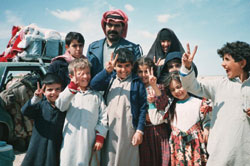 |
|
Figure 7: Refugee camp during the 1990-91 Iraq war. |
Figure 8: Refugees from the camp. |
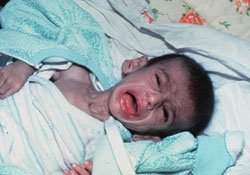 |
 |
|
Figures 9-10: This infant from the refugee
camp still had a good appetite but needed immediate nutritional
resuscitation. |
|
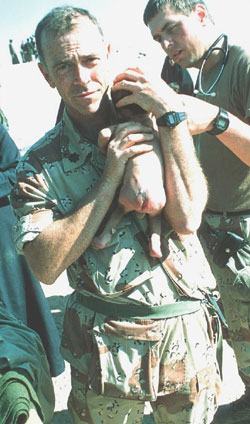 |
 |
|
Figure 11: One of the infants who suffered
from chronic diarrhea. |
Figure 12: A toddler from the refugee camp who
suffered from chronic diarrhea. |
You probably are well aware that you don’t have to go to a war-torn or developing country to see cases of advanced malnutrition. The baby in figure 3 is just one of numerous examples of patients with severe malnutrition that we have had right here at home. One might think, “How can that happen.” Obviously, neglect and abuse should come to mind early on. But the malnutrition of these patients and some others we have had was a consequence of good people with poor parenting skills and no extended family available to support and advise. In my experience, it crosses all socio-economic lines. We have had some whose parents were illiterate and some with advanced degrees. Babies can seemingly become clinically malnourished in the “blink of an eye.” Good well-child care and education is the best prevention. Again, I’m no expert, but it’s not hard for me to see how a case of acute gastroenteritis that evolves into some chronic diarrhea over a few weeks and a missed well-baby visit or two, until the next thing you know the baby is in the ER with a poor appetite and not acting right with this marasmic appearance. Parents have been guilty of dumber things that can occur without malice. However, always have abuse in the back of your mind, at least at first.
Columnist comments
When I was pediatric resident in the mid-late 1970’s, parents making their own formula and baby food seem to be very popular. We were even taught in residency how to teach parents to make their own formula if they so desired. However, I could not tell you how to do it now if my life depended on it. Anyway, as a result, we occasionally admitted babies with malnutrition and weird electrolyte abnormalities because of improper mixing or using untested, colloquial formulations. We would also see toddlers coming in with foreign bodies such as peanuts, popcorn, and chunks of celery, etc. stuck in their airway. It seems that these problems are much less common nowadays, largely through the efforts of primary care providers providing anticipatory guidance as part of good well-child care, and the affordable, easily available commercially prepared formulas and baby foods.
 |
|
Figure 13: A book for parents that includes
nutritionally sound recipes for toddlers, along with helpful advice.
|
However, having said that, there’s much to be said for preparing foods for infants and young toddlers in the home, not the least of which is knowing exactly what is going into it. There’s really no reason for parents to be afraid to make their own formula and baby foods who are motivated to learn how to do so. For those interested, I recently discovered an excellent resource that was written with these parents in mind; a book titled, “Baby Love” (figure 13), by Norah O’Donnell and her husband, Chef Geoff Tracy (figure 14). I have read it and can tell you that its 148 pages are loaded with healthy, nutritionally sound recipes, accompanied by excellent photographic illustrations and good advice; from avoiding honey and soft cheeses in infants to common sense nutritional recommendations. While Geoff Tracy is a trained chef from the prestigious Culinary Institute of America, to make sure the preparations are appropriate for children, the authors received significant input from recognized nutritional experts from the American Academy of Pediatrics, which are referenced in the book. I am confident enough in its content, that we gave a copy to our son and daughter-in-law, who have one toddler and one on the way. Norah and Geoff met as highly gifted students at Georgetown University, and married ten years later. Norah has subsequently become the Chief Washington Correspondent for MSNBC, and “Chef Geoff” has five enormously popular restaurants in the Washington, D.C., area, and are both heavily involved in numerous charitable organizations, as noted below.
 |
|
Figure 14: The book’s authors, Norah
O’Donnell and her husband, Chef Geoff Tracy. |
This book actually ties in a bit with the column above. Norah’s father, Colonel (Retired) Frank O’Donnell, MD, a Preventive Medicine Physician, and I were both stationed at Brooke Army Medical Center in San Antonio in the 1980s and early 90s, and were both deployed to the same areas of operations during the first Iraq war (figure 15 during a brief get together prior to the ground war). During those years in San Antonio, I also functioned as the O’Donnell’s pediatrician on occasion, as we were also neighbors. Frank and I were then co-located at Walter Reed Army Medical Center for a few years and later at The Office of The Army Surgeon General, where he was my supervisor until I retired from active duty. We recently revisited some of those old days (figure 16) at a Wounded Warrior’s dinner event in Washington, D.C., hosted by the Walter Reed Auxiliary (WRA), which is headed up by Frank’s wife, Norah (figure 17 shown on the right with my wife Ellen and the most senior member, Carola Artiss in the center). This event was held at one of Chef Geoff’s restaurants in November 2010, and free to any Gulf War veteran. The senior Norah and the members of the WRA spend a great deal of time (and money) throughout the year, organizing these service-related and fund-raising events and doing other work for the benefit of these returning soldiers and their families. Virtually anything that any soldier in the greater DC area needs is quietly and unceremoniously provided by the members of the Walter Reed Auxiliary.
 |
|
Figure 15: Norah’s father, Colonel
(Retired) Frank O’Donnell, MD, a Preventive Medicine Physician, during
Operation Desert Storm. |
 |
|
Figure 16: Colonel O’Donnell and I during
a Wounded Warrior’s dinner event in Washington, D.C., hosted by the Walter
Reed Auxiliary. |
Lastly, in addition to raising their three children, writing an excellent cook book for babies and children, and pursuing very successful careers, Norah O’Donnell and Chef Geoff Tracy have also found a way to donate significant time and money along with Norah’s parents and the Walter Reed Auxiliary to help soldiers in need. At that event in November, my wife and I were fortunate to get a glimpse back into that world that we left behind, and the greatness it inspired, when I took my uniform off for the last time in 1997.
 |
|
Figure 17: (Right to left) Colonel
O’Donnell’s wife, Norah, Carola Artiss, and my wife Ellen during the
November 2010 Wounded Warrior’s dinner. |
So as the late Paul Harvey would say, now you know “the rest of the story.”
Disclosure: Dr. Brien has no direct financial interest in any of the products mentioned in this article nor is he a paid consultant for any companies mentioned.
